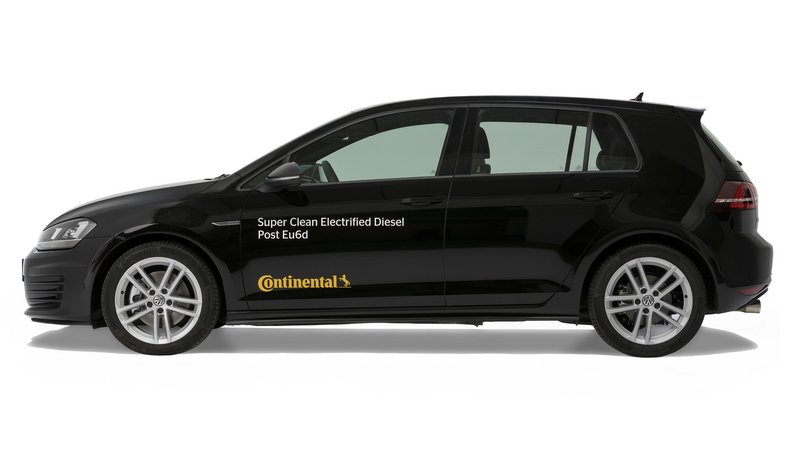Continental Presents Technology for the Diesel Engine of the Future
- At the Vienna Motor Symposium, Continental will present system solutions for extremely low-pollutant diesel engines
- 60 percent reduction in nitrogen oxide emissions – plus lower fuel consumption
- Comprehensive technology package comprises highly flexible fuel injection, 48-volt hybrid system, SCR exhaust aftertreatment and electrically heated catalyst
- Further significant fuel savings achievable with predictive driving
Vienna, Regensburg, April 25, 2017. A 48-volt mild hybrid system not only reduces fuel consumption (and therefore CO2 emissions) but can also achieve significant reductions in pollutant emissions from diesel engines. This is demonstrated by test results that technology company Continental will unveil at the Vienna Motor Symposium 2017. By making various modifications to a Euro 6 Diesel standard vehicle, engineers at Continental were able to reduce nitrogen oxide emissions by 60 percent. Even in real-world testing on the road, over an extended temperature range, this keeps NOx emissions well below the legal limits. And while many other measures aimed at reducing pollutant emissions come at the expense of increased fuel consumption, with Continental’s technology CO2 emissions actually show a two percent fall. “The diesel engine will continue to play an important role in meeting mobility needs for the foreseeable future,” says José Avila, President of the Powertrain Division and Member of the Executive Board of Continental. “So it is vital for us to develop the technology to support extremely low-pollutant diesel operation.”
Highly Flexible Fuel Injection
The engineers implemented their clean diesel vision in several stages. They began by replacing the standard injection system with Continental’s PCRs5 piezo common rail injection system. This operates with maximum injection pressures of 2,500 bar. With the help of highly dynamic valve timing it is possible to perform multiple, very closely spaced and very precisely metered injections per cycle. In this way a minute amount of fuel can be injected into the cylinder after the combustion event. This fuel is ignited only when it reaches the catalyst, thereby accelerating catalyst warm-up. This has important implications because the SCR catalyst has to reach a certain minimum operating temperature before it can begin converting nitrogen oxide emissions. Tests show that this single measure – post-injection – can cut the SCR catalyst light-off time by around eight minutes, resulting in a reduction in cumulative nitrogen oxide emissions under the future WLTP (Worldwide harmonized Light-duty Test Procedure) driving cycle of 37 percent.
Innovative 48 Volt Hybrid System
However, there is no question of Continental using post-injection in isolation, because this would increase fuel consumption by around four percent. Among other measures a 48-volt hybrid system based on a belt-driven starter-alternator is also used. The electric motor, with a rated output of around 15 kW, not only allows braking energy to be recuperated and stored as electricity in a small lithium-ion battery but can also assist the internal combustion engine during short, sharp bursts of acceleration. This reduces the peaks in nitrogen oxide emissions that are a feature of diesel engines under very sudden, heavy throttle application. By cutting the relative proportion of accelerating power that has to be supplied by the combustion engine – something the engineers refer to as ‘phlegmatization’ – the 48-volt system can reduce nitrogen oxide emissions by a further three percent over and above the reduction achieved by post-injection. At the same time CO2 emissions are cut back by an additional three percent approximately.
SCR Exhaust Aftertreatment and Electrically Heated Catalyst
A further reduction in emissions is achieved by the use of a close-coupled electrically heated catalyst (EMICAT). Irrespective of engine operating strategy the heated catalyst, with a transient power rating of 3 kW, quickly brings the downstream-mounted SCR catalyst up to operating temperature, allowing it to start converting nitrogen oxides. The aqueous urea solution (AdBlue) used for SCR catalysis is injected into the exhaust stream immediately downstream of the heated catalyst. This arrangement guarantees good mixing of the exhaust gas and the urea, so that it is not necessary to fit a separate mixer. The heated catalyst reduces nitrogen oxide emissions by a further 14 percent. Fuel consumption is unaffected, since the electrical energy used for heating purposes is supplied entirely from braking energy recuperated by the 48-volt system.
Energy Optimization due to Connected Energy Management
An additional significant reduction in emissions is achieved with the help of connected Energy Management (cEM). “The beauty of ‘connected Energy Management’ is that we can implement a more energy-efficient driving strategy simply by using an improved database,” says Dr. Oliver Maiwald, Head of Technology & Innovation with Continental’s Powertrain Division. “When the cEM control unit is aware of the upcoming route (thanks to the navigation system or learning algorithms), it can decide in advance when the vehicle should coast and when it is best for it to recuperate braking energy, thereby saving fuel and emissions,” says Maiwald. The ‘Super Clean Electrified Diesel’ presented in Vienna uses a cEM Traffic Light Assist (TLA) function to achieve a further reduction of nitrogen oxide emissions as well as a reduction in fuel consumption. The TLA predicts when the next traffic light – which may not yet actually be visible to the driver – will be on red and can then use this additional information to improve coasting, recuperation and braking management.
In total, the measures featured on the test vehicle presented in the lecture in Vienna deliver a very significant 60 percent reduction in nitrogen oxide emissions, while at the same time achieving a slight drop in fuel consumption, which is down two percent – compared to a Euro 6 Diesel standard car. “In other words we have resolved a classic conflict of objectives in diesel engine development,” says José Avila, “showing that a clean diesel engine with emissions well within the legal limits doesn’t have to consume more fuel.”
Click here to download the film “Measuring fuel consumption and emissions”.

Simone Geldhäuser
Head of Media Relations, Spokesperson Finance, Business and Technology
Vitesco Technologies


